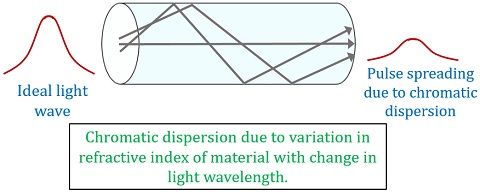Definition: The term dispersion is widely used when we talk about travelling of light pulse, more specifically we can say light-wave transmission. Dispersion in an optical fiber is the spreading of light pulses when the wave travels through an optical fiber from an end to another.
It results in some variation of the actually transmitted wave through an optical fiber. Due to the dispersion of light waves, various adverse effects are noticed on the signal being transmitted.
Information or signal through an optical fiber is transmitted in the form of digital pulses that are based on binary coding.
Now, the question arises why dispersion occurs?
As we know that light through an optical fiber travels by taking multiple paths within it. Due to propagation through several paths, the light waves reach the destination in different time duration. Resultantly, that will cause dispersion of light wave through the fiber.
It is noteworthy here that light propagates inside the optical fiber through total internal reflection.
Types of Dispersion in Optical Fiber
- Intermodal dispersion
This type of dispersion in optical fibers occurs because different light rays that propagate through a multimode fiber have different propagation delays. So, light shows dispersion due to early reaching and sometimes delay in reaching the other end of the fiber.
It is sometimes also known as multipath time dispersion.
Graded index optical fibers efficiently make use of total internal reflection. So, we can achieve light ray without much dispersion in propagation through graded index optical fiber.
- Chromatic dispersion
It is also known as material dispersion. Refractive index of the material varies when the light of different wavelength propagates through the fiber. As we know a light ray is composed of components of a different wavelength.
Chromatic dispersion is a combination of material and waveguide dispersion.
As the wavelength increases, the refractive index of the material decreases and vice-versa. Due to this if light rays of different wavelength propagate through the fiber, then it will make propagation through a different angle of refraction of light. This is known as Chromatic dispersion.
It is generally discussed in case of single mode optical fiber. But, it also occurs in multimode optical fibers. Effect of chromatic dispersion is somewhat smaller as compared to intermodal dispersion.
Let us now discuss how dispersion effects data transmission.
Effect of dispersion in data transmission
- Dispersion corrupts the transmitted signal: Suppose optical data in form of digital pulses are transmitted. But after propagation at the destination, a spreaded signal is achieved. Due to this broadening, there are chances that these light pulses will get merged and hence the actual information will not be obtained.
This is clearly represented in the figure shown below:

- Limits the information carrying capacity: The transmission capacity of a system used for transmitting signal is an important factor. When a large number of light pulses are transmitted through the fiber and if at the other end all the pulses get fairly recovered. Then it is said to a high transmission capacity optical fiber.
So, when the dispersion rate of consecutive light rays is higher, then it will lead to fewer chances of proper signal recovery at the other end.
For this reason, sufficient time interval must be provided between the consecutive light pulses. So that spreading will not result in the mixing of information. But this will surely limit the number of pulses transmitted through the fiber.
Therefore, the information carrying capacity of the signal gets reduced. Hence, the smaller the dispersion, the larger will be the current carrying capacity of the system.
So, we can say that there are various factors that are responsible for the dispersion of light through an optical fiber. At the same time if the spreading will become severe then it can cause deterioration of actually transmitted information.
